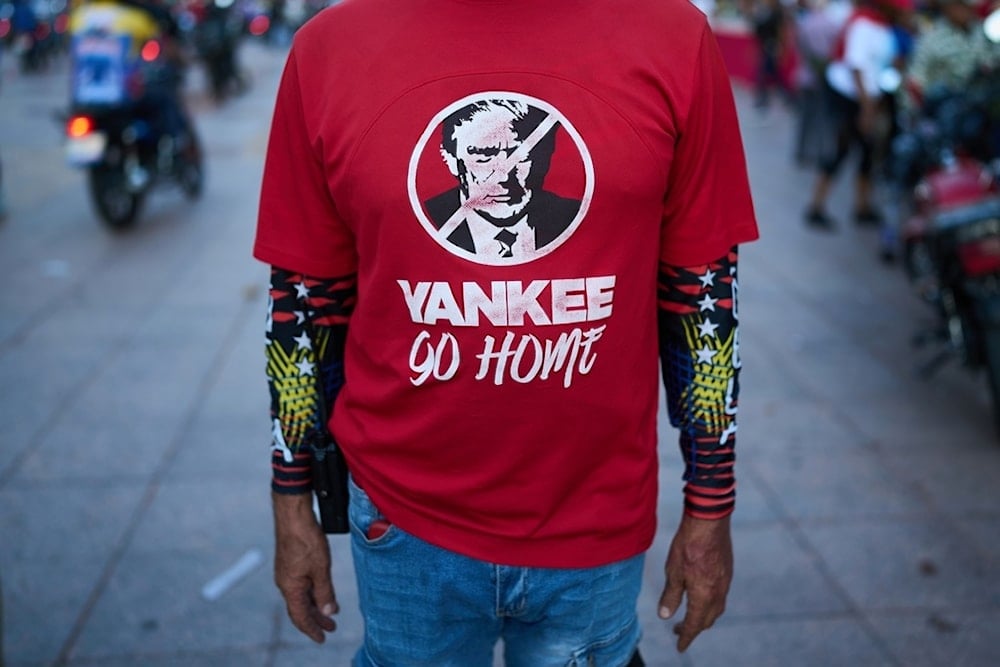USS Gerald R. Ford redeployed to Caribbean amid US buildup
The USS Gerald R. Ford has been redeployed to US Southern Command as part of a growing military buildup in the Caribbean targeting drug trafficking operations.
-

A man wears a shirt with an image of US President Donald Trump during a rally against foreign interference, in Caracas, Venezuela, Thursday, October 30, 2025 (AP)
The United States has moved the aircraft carrier USS Gerald R. Ford from the Mediterranean to the US Southern Command (SOUTHCOM) region as part of a broader expansion of naval operations in the Caribbean, US defense sources told the US Naval Institute News (USNI) on Tuesday. The redeployment comes as Washington intensifies military activity under the stated objective of "countering drug trafficking networks" in the Western Hemisphere.
The Pentagon first signaled the move in late October, when spokesperson Sean Parnell announced that the Gerald R. Ford Carrier Strike Group had been ordered to reposition in support of US operations overseen by SOUTHCOM. According to USNI, the strike group, including the carrier, its air wing, and accompanying warships, began redeployment shortly afterward.
The carrier group passed through the Strait of Gibraltar on November 4 and has since been operating off the western coast of Africa, several miles west of Cape Verde. Witness accounts indicated that the USS Gerald R. Ford is being escorted by the USS Bainbridge, a guided-missile destroyer.
The US redeployed the USS Gerald R. Ford carrier group to the Caribbean under the pretext of anti-drug missions, escalating military pressure near Venezuela in a move seen as intimidation and regional provocation.
Increased US military presence in the Caribbean
Over recent months, the United States has expanded its naval, air, and ground presence across the Caribbean, with officials in Washington claiming the operations are aimed at "strengthening counter-narcotics and counterterrorism capabilities." The move marks one of the most significant deployments to SOUTHCOM waters in years.
The escalation coincides with a series of strikes authorized by US President Donald Trump since early September. US military forces have targeted what Washington described as drug-trafficking vessels across the Caribbean Sea and the Eastern Pacific.
According to US defense briefings, these operations have resulted in the destruction of approximately 20 vessels and the deaths of at least 75 individuals as of November 10.
US military buildup in Caribbean aimed at regime change in Cuba
With the largest US military concentration in the Caribbean since the 1962 Cuban missile crisis, a new Foreign Policy (FP) report warns that Washington’s announced campaign against narcotics trafficking in the region masks a far broader strategic objective.
The removal of Venezuela’s President Nicolas Maduro and, by extension, pressure on Cuba by cutting off Venezuelan oil supplies.
The report says roughly 10 naval vessels and some 10,000 troops, including a carrier strike group led by the USS Gerald R. Ford and elements of the 160th Special Operations Aviation Regiment, are now positioned in the region, a posture that raises the prospect of direct military action against Venezuelan government targets and carries grave implications for Havana.
It is worth mentioning that the White House has framed recent operations as an intensification of counter-narcotics efforts, with senior US officials labelling traffickers as foreign terrorists and authorizing strikes on vessels alleged to be part of the trade.
Foreign Policy argues that the campaign’s political logic extends beyond drugs; the removal of Maduro would, in this account, enable a US policy aimed at severing Caracas’s lifeline to Havana and thereby accelerating a long-standing Republican objective of overthrowing the Cuban state.
"We are going to kill people that are bringing drugs into our country, OK? We are going to kill them," the report quotes President Donald Trump as saying, adding that "The land is going to be next."

 4 Min Read
4 Min Read








